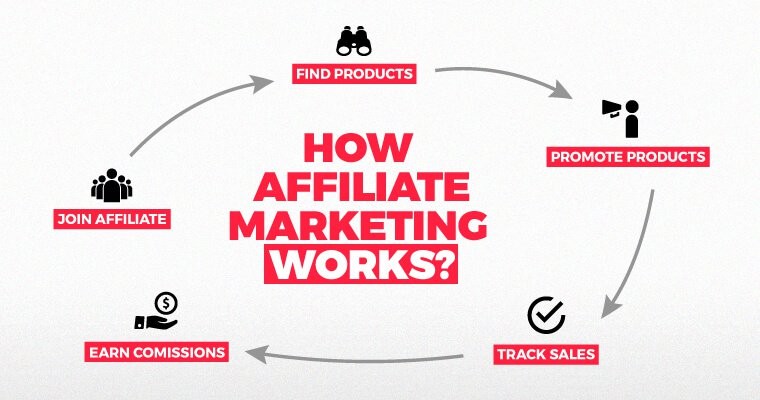Contents
If you want to do your business online and you don’t have a product to sell then affiliate marketing is the best option for you.
In this marketing tactic, you can promote another company’s product or services and can earn commission and payout.
So, for moving further, let’s know what is affiliate marketing, how it works, what is the pricing model, what is the types of affiliate marketing and why you have to choose affiliate marketing.
What is Affiliate Marketing?
Affiliate marketing is an advertising model in which a company pays a commission to the third-party publisher to generate traffic or leads to the company’s product and services. The third-party publishers are affiliates, and the commission fee encourages them to find ways to promote the company.
Affiliate marketing is a process of promoting another company’s product in return for a commission or payout for each sale.
How does affiliate marketing work?

Affiliate marketing begins when the affiliate marketer joins an affiliate program. To take part in an affiliate marketing program, you will need to:
Find and join an affiliate marketing program whatever you want
Choose the offers that you want to promote
Obtain a unique ID or specific URL for each offer
Share those links or codes on your blog post, social media platforms, YouTube channel, or website.
When a potential buyer clicks on the link to visit the merchant’s site, and completes the sale process, you will get a commission or your decided payout. Commission rates vary dramatically, it depends on the company and the affiliate program.
Types of affiliate marketing:
There are three types of affiliate marketing: Unattached affiliate marketing, Related affiliate marketing, and Involved affiliate marketing. let’s know in brief..
Unattached Affiliate Marketing:
In the unattached affiliate marketing business model, the affiliate marketer has no connection with a product or service which they are promoting. They have no expertise or related skills or authority in the niche of the product, nor can they make claims about its use. There is no connection between the affiliate marketer and the end consumer.
Mostly, an unattached affiliate will run pay-per-click affiliate marketing campaigns, using an affiliate link in hopes that shoppers will click it and make a purchase on their own.
Unattached affiliate marketing may be attractive due to its lack of commitment, it’s mostly for those who simply want to generate an income without investing in the product or customer relationship.
Related Affiliate Marketing:
This is an advertising model, in which affiliates have some sort of influence in the niche and an established following, and can therefore offer some authority.
Related affiliate marketing is for those who don’t generally use the product or service, but who are somehow related to the niche audience. This is the advantage of this type of affiliate marketing the affiliate has enough impact and expertise to generate traffic, and their level of authority makes them a trusted source.
Involved Affiliate Marketing:
Involved affiliate marketing is for those who are closely joined to the product or service they’re promoting. The affiliate has used or currently uses the product themselves, trusts that it will provide a positive experience, and has the authority to make claims about its use. It builds a deeper relationship between the affiliate and the product or services they are promoting.
Of course, it takes time to build creditability and requires more legwork, but it will likely result in greater payoffs down the road.
How Do Affiliate Marketers Get Paid?
It involves many types of pricing models. let’s discuss what kind of conversions can get an affiliate marketer a commission.

CPA – Cost Per Action:
CPA marketing is the most popular pricing model as it earns you a commission for a specific action. Most of the affiliate programs use it as it’s broad enough to be ideal for many different offers. The action is always specified by the affiliate network so once the affiliate marketer gets the affiliate link, they’ll know exactly how to promote it.
CPL – Cost Per Lead:
CPL payment model earns affiliate marketers an affiliate commission every time a user signs up. This is also a very popular payment model as it’s used for the most of lead generation, vouchers, and sweepstakes types of offers. All the user has to do is leave their contact details such as name, email address, anbd phone number, and the affiliate will score their conversion.
CPC – Cost Per Clicks:
CPC model might be the rarest of affiliate marketing payment models, as it’s only applied by the biggest merchants in order to increase brand recognition. Such an affiliate program will earn affiliate marketers a commission for every click on the affiliate link.
CPI – Cost Per Install:
CPI is a payment model in which affiliates earn a commission for each time a user installs an app on their mobile (or desktop) device. If affiliates want to promote games and apps, this is most likely the way their commission will be calculated.
This payment model is mostly popular for advertising mobile applications and games but can also be used for other software.
CPM – Cost Per Mille:
In a simple word, CPM means cost per thousand impressions. In this pricing model, affiliates get a commission for one thousand views or clicks of an advertisement. CPM rates may vary on different affiliate networks, but they are generally too low in our opinion.
It is a pricing model for this marketing tactic in which the merchants share a portion of their conversions with the publishers. Revenue Share model is mostly used by affiliate programs or merchants who intend to promote more serious offers, often related to casino and gambling verticals.
Why Affiliate Marketing?
Affiliate marketing can yield special rewards for the advertising company and the affiliate marketer. It involves many types of benefits for marketers.
Low risk:
It is a way to generate income online with low risk. The initial costs to set up your website and traffic sources are minimum as compared to launching a product.
If affiliates find that certain products are not working with their audience, they can quickly pivot to begin promoting new items.
Flexibility:
Like other ways of generating income with digital marketing, affiliate marketing affords great flexibility. So long as you can access the internet you can use it anywhere.
You get the capability to work and promote your products independently.
Your affiliate program will undoubtedly have guidelines that you need to follow but it is ultimately up to you how you choose to engage with your audience.
More reach:
Affiliate marketing is the same beneficial to the companies who create the affiliate program.
One of the largest advantages of running an affiliate program is the ability of the company to extend its reach.
Conclusion:
So, we discussed all about affiliate marketing, how it works, and the pricing model used in affiliate marketing, hope my blog will help you to grow your affiliate marketing sales. In affiliate marketing, you have to choose the right affiliate marketing program for you because it will gives you a best earning.


0 Comments